Many visitors are tempted to Lanzarote by the offers of cheap all-inclusive resorts found across the island. However, there is so much more to the island than resort pools and in this post, I will share some of the wonderful things to do on Lanzarote that I discovered on my recent visit to the island.
I’ll be straight up about it, although Lanzarote has a mixed reputation around Europe, even attracting some unflattering nicknames such as Lanza-grotty, a bit of me fell in love with the island that makes up part of the Canary Islands.
Many visitors to the island spend most of their days sipping gin and tonics by the pool, only venturing out for an organised day tour that crams as many places as possible before getting back in time for a gluttonous buffet dinner.
While there is nothing wrong with this, I feel it is doing the island a disservice and with so many things to do in Lanzarote, visitors should really try to explore further.
Coming your way in this post - click to expand ->
Note – Please know, some of the external links on this page are affiliate links, this means that if you purchase after following one, I make a small commission from the sale at no additional cost to yourself.
The Travel Blogs Guide to things to do on Lanzarote
In this post, I’ll cover many of the best things to do in Lanzarote complete with my (mostly) first-hand experience, opening hours and price, where applicable, and the amount of time I’d recommend for visiting.
Some of them will require hiring a car, if you plan to do this I would also recommend reading my guide to Spanish driving laws.
This is a pretty long post as I will be sharing quite a lot of ideas as well as my experience, to read it all I’d estimate it’s a 6-7 minute read, but feel free to use the map or the contents just below to get to where you need to go quickly!
The shaping of Lanzarote
Lanzarote is one of the many islands that make up the ruggedly photogenic Canary Islands. Although they are just off the West Coast of Africa, they are considered a part of Spain and Spanish is the local language.
The defining moment the history of Lanzarote was in the 1700s when multiple violent volcanic eruptions shook and reshaped the island, changing the life of residents forever.
This fiery destruction has left behind a geologist’s dreamland of stark, alien-like landscapes, stunning caves and a cultural history that shaped the work of the island’s most famous artist, César Manrique.
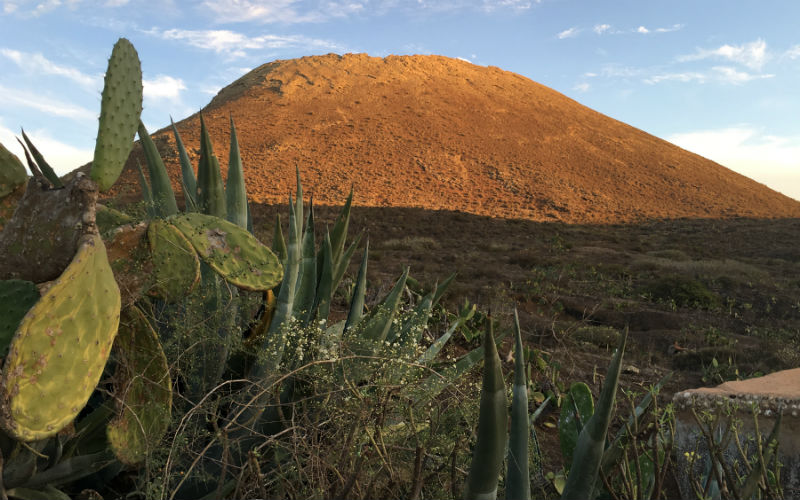
While there are many Lanzarote day trips and tours, my recommendation would be to hire a car for at least two days and discover the island for yourself.
Here is my list of places to convince you to leave the gin and tonic by the pool for the day and discover some of the wonderful sights of Lanzarote.
Discover the work of César Manrique
Like most people, probably, I hadn’t heard of César Manrique before arriving in Lanzarote, but you don’t have to explore far to discover the influence of his work and how he shaped tourism on the island.
César Manrique was born in Lanzarote, studied art in Madrid, worked in New York for a few years before returning to his homeland.
His work spans from Impressionist and Modern Art painting and sculptures to visionary architecture and he has helped to make Lanzarote the international tourist destination it is today.
Throughout this whole post you will see his name mentioned with various projects he has been involved in, but here are some of the best places to learn more about the man that made Lanzarote.
1. Casa del Palmeral
Otherwise known as Volcano House, Casa del Palmeral is an art gallery dedicated to César Manrique and his contemporaries in a house that he designed himself and lived in for over 20 years.
While the paintings were a little lost on me (I’m a bit of a philistine heathen when it comes to paintings) the house didn’t disappoint.

From the
The gallery has a designed route that guides through cave rooms built around five natural volcanic bubbles and interconnected by tunnels excavated in the lava, complete with a small, but gorgeous, swimming pool.
It definitely has a touch of a mini Playboy Mansion about it.

The final room is a large, open gallery, showcasing some of his larger paintings and a couple of videos (in Spanish) about his life.
Finally, before we left we had a quick coffee and snack in the small cafe, complete with a couple of friendly cats.
As an introduction to César Manrique, I would highly recommend visiting the Fundacion, even if you (like me) aren’t a massive art buff, the gallery does help get a feeling for the man and his motivations.
Casa del Palmeral Visitor Information
Hours: Open every day from 10am – 6pm (holidays may vary)
Cost of entrance: €8, children under 12 €1
How much time to spend there: 1 – 2 hours
More info: Volcano House
2. The Cactus Garden
As we approached, The Cactus Garden gave none of its secrets away, all that marked the location was a traditional windmill. Well, that plus the car park with large signs saying welcome to the Cactus Garden.
Designed by César Manrique, El Jardin de Cactus is located in the north of Lanzarote, close to the village of Guatiza. The garden is home to more than 4500 cacti of 450 different species in a disused quarry.
Having parked the car, we paid our entrance fee, entered the garden and were immediately amazed. We found we stood at the top of the old quarry with the garden laid out in front of us as carefully terraced slopes running around the outside and the windmill towering above to our left.
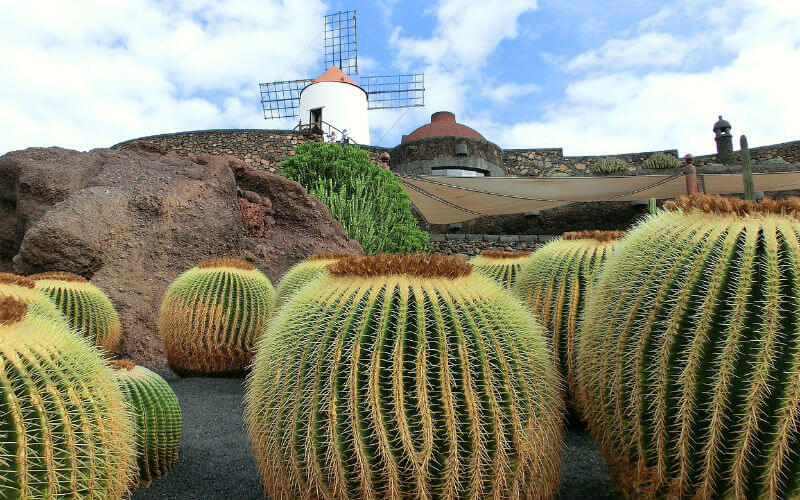
Each of the cacti have a small plaque marking the species and origin. We were quickly putting our botany skills to the test, guessing where each one came from as we slowly made our way down to the centre of the bowl and the small lake at the lowest point.
I’d highly recommend finding some time to visit The Cactus Garden. I’m not sure what it is, but there is something fascinating about cacti and I had a lot of fun exploring and taking photos of the many different types.
As well as the windmill, there is also a cafe and small gift shop within the grounds, selling local souveniers, and of course cacti.
The Cactus Garden Visitor Information
Hours: Open every day from 10am – 5:45pm (holidays may vary)
Cost of entrance: Adults €5.80, children aged 7 – 12 €2.90
How much time to spend there: 1 hour, longer if you want to enjoy the café.
More info: Cactus Garden
3. César Manrique House Museum – Haría
We didn’t actually make it to César’s house, but it came highly recommended by a German couple we got talking to at Volcano House.
The couple have visited the museum every year for more than the last 20, which seemed a little over-enthusiastic to me, but still, a solid recommendation.
The house is in the small village of Haria, in the north of Lanzarote, and was the artist’s workshop in the later years of his life before his death in 1992. It now remains untouched after his death with many of his utensils and personal objects on display, kind of a time capsule standing as a testament to his work.
César Manrique House Museum Visitor Information
Hours: Open every day from 10am – 5:45pm (holidays may vary)
Cost of entrance: €10, children 12 or under €1
How much time to spend there: 2 hours
More info: Manrique House Museum
If you plan to visit both the César Manrique House Museum and Volcano House, you can purchase a multi-ticket for €15, saving €5.
4. Monumento a la Fecundidad
The chances are that if you hire a car during your visit in Lanzarote, you will pass the Monument . . . many times as it sits in the geographical centre of the island.
The Monument was designed by César Manrique and stands in honour of the Lanzarote farmers, past and present, who struggle in their daily lives to produce a living from the volcanic land of Lanzarote.

Monumento a la Fecundidad Visitor Information
Hours: Always accessible
Cost of entrance: Free
How much time to spend there: 10 – 15 mins
5. Museo al Campesino
Just behind the Monumento a la Fecundidad is the Museo al Campesino. Broken up into multiple rooms, each of them represents a different traditional island craft. With multiple shops, this is one of the best places to pick up your authentic Lanzarote souvenirs
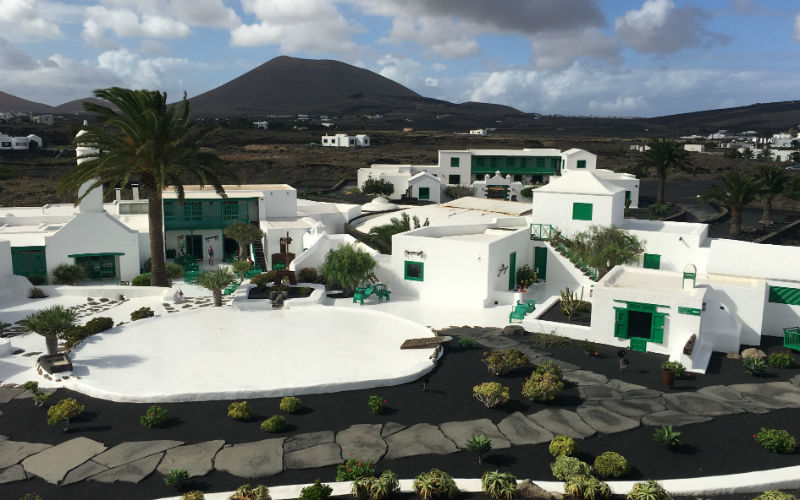
Museo al Campesino Visitor Information
Hours: Centre, shop and cafe: 10am to 5:45pm (from 9am in the summer). Restaurant: 12pm – 4pm
Cost of entrance: Free
How much time to spend there: 30 mins (unless you love to shop or want to eat, then maybe a little longer)
More info: Museo al Campesino
A few suggested Day Trips
If you don’t fancy a rental car when you visit Lanzarote, there are plenty of day trips and excursions to discover the César Manrique’s influence on Lanzarote.
Get into Volcanic Lanzarote: A visit to Timanfaya National Park
As mentioned above, over 250 years ago, much of Lanzarote was covered in lava by violent volcanic eruptions. Although there are some places where you can walk on the lava, the majority of the black stuff makes up the protected area of Timanfaya National Park.
Also known as Las Montañas del Fuego, a visit to Parque Nacional de Timanfaya is a highly recommended experience that you can easily do as part of an organised tour or hire a car and drive there yourself, which I would recommend.
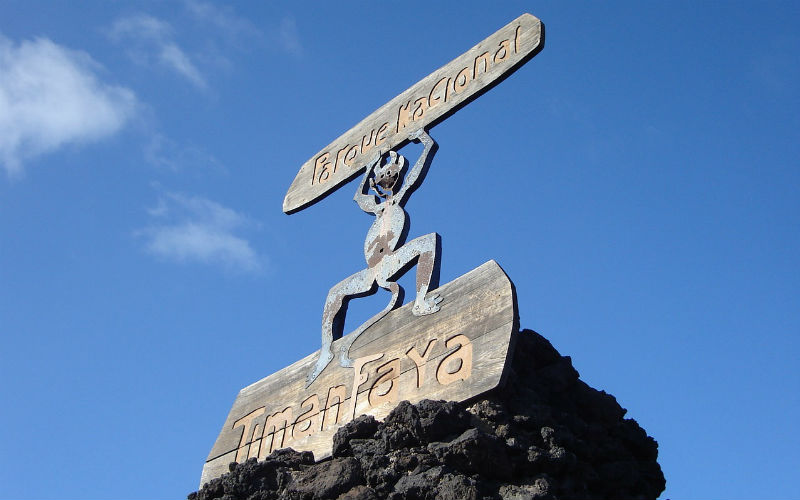
6. Car & Bus Tour
This is how we visited. We drove ourselves to the entrance, located in the west of Lanzarote, off the LZ-67 between Yaiza and Tinajo, paid the guards the 8€ per person entrance fee (young kids are free) and drove on through to the visitor centre which is about 1 km up the road.
If you decide to
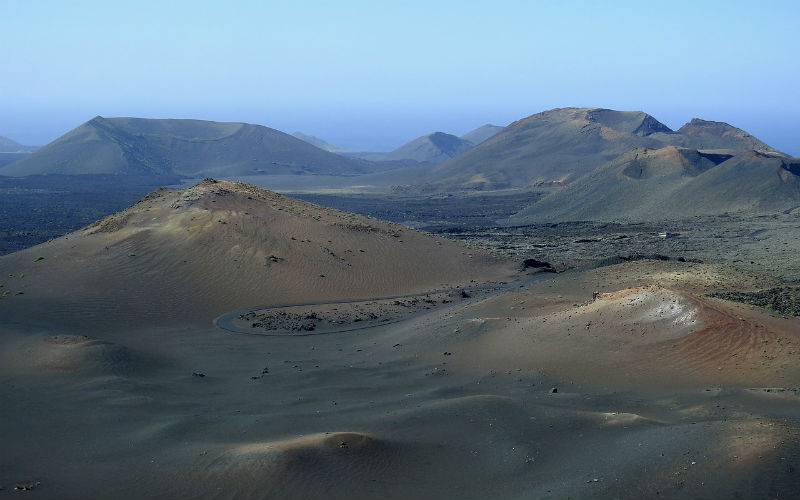
The main part of a park visit is made up by a bus ride through the lava fields accompanied by a recorded commentary that plays Spanish, English and German, talking about life on the island before and after the eruptions.
Once we had made it to the car park, we were directed to the next bus and hopped on. The bus ride took about 30 minutes, most of which was spent looking nervously out of the window, wondering how the driver could actually navigate the large coach along the tiny roads and through the carved out lava.
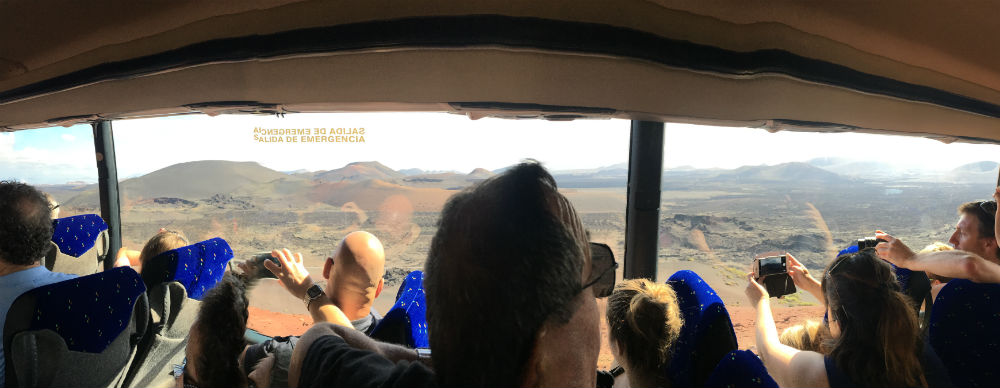
The views of the landscape are spectacular, the different shades of volcanic ash as it changes from red to black with the odd green shrub growing out of the scorched earth . . . I imagine the park would be a stunning location for many a sci-fi movie.
As the bus climbs higher there are some wonderful views back to Yaiza before reaching the highest point where we could look down into one of the many volcanic craters in this area.
When our bus tour was over, we spent some time looking around a small shop selling Lanzarote souvenirs and
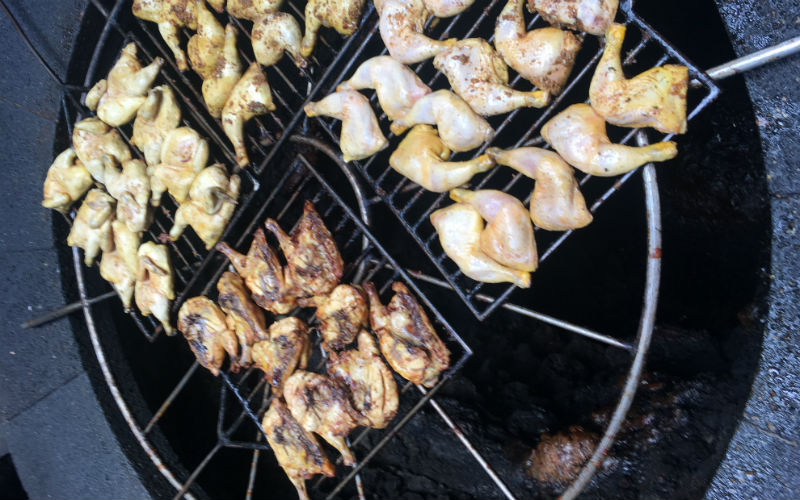
The grill is basically a giant well dug into the volcano, but rather than water at the bottom, there is immense heat that the restaurant uses to cook some of their food. We were able to walk up and take a look down. If you do too, be warned, as you peer down into the oven, you will get a hot blast hit your face.
7. Timanfaya Park volcano displays
Outside the

The first is where they pour a bucket of cold water down a pipe where it is vaporised by the natural heat that still resides in the volcano and explodes back out about 2 seconds later.
If you want to catch a photo of the spray, you had better be quick on the trigger.
The other part is where they have a small fire going, sparked by the heat of the volcano only a few metres below your feet.

They are both impressive displays of the volcano, but I also found them worrying, like they are just poking the volcano with a stick, making it do tricks for the public. I worry that one day it will get tired of performing and explode . . . I hope I’m nowhere near when it does.
Timanfaya National Park opening times
Hours: Timanfaya National Park can be visited daily between 9am and 5pm (7pm during summer season)
Timanfaya National Park prices
Cost of entrance: Adult: €10 per adult including coach tour. Children between 7 and 12 years €5.
More information
How much time to spend there: A visit with
More info: Timanfaya National Park
8. Timanfaya National Park camel ride
Yep, you read that right, you can also visit by camel!
The Echadero de los Camellos is also located along the LZ-67 in Parque Nacional de Timanfaya, a little further south of the main car entrance.
Personally, I’m not a big fan of mass tourism animal rides so I chose not to do this.
If you fancy a camel ride tour of Timanfaya, it costs €12 per camel, but each camel can take two people with the tour lasting 20 minutes.
9. Timanfaya visitor centre
If you are interested in learning more about Lanzarote’s volcanoes above and beyond what you learn on the tour then just south of Tinajo, on the LZ-67, is the main visitor centre packed full of information.
Given how busy the tours get, I’d definitely recommend visiting the lava fields first and doing Timanfaya National Park bus tour before it gets too busy, then heading to the visitor centre afterwards.
Vistor Information
Hours: The visitor centre can be visited daily between 9am and 5pm (6pm during summer season)
Cost of entrance: Free 🙂
How much time to spend there: 30 mins to an hour. It depends how much you can read about geology before your eyeballs try to run away. I mean, it’s good to learn, but sometimes reading about the actual scientific ins and outs can be pretty dull. Still, worth popping in if you have a car.
Recommended Timanfaya National Park Tours
Find Lanzarote’s black beaches
The black beaches were one of the things I was looking forward to seeing as they are rare. There are a few to choose from along the island’s west coast, including El Golfo and Las Salinas, more on both of them in a bit, but the one that almost everyone wants to see is Playa del Charco de

10. Playa del Charco de los Clicos & El Lago Verde
Also known as the one with the green lake of green lagoon, El Lago Verde, is probably the most well known of the Lanzarote black beaches. It’s worth noting that this beach is for viewing rather than taking a picnic to and relaxing for the day. The ocean is far
The local name for the beach is La Laguna de
The beach is formed in a volcanic crater of which half is submerged. But it is the The lake part is that draws people to view.
The lake shimmers a bright emerald green in stark contrast to the surrounding black sand. The green comes from a type of phytoplankton that feeds on the volcanic elements in the lake and is thought to be unique to the area.
El Lago Verde is a popular attraction with many coach tours so it is quite possible that it will be busy when you visit. However, with visits generally taking no more than 30-minutes you can just relax and it won’t be long before it quietens down. As with any popular site there will be locals selling souvenirs and welcome refreshments.

11. El Golfo
Next to El Lago Verde is El Golfo, is a quiet fishing village set among the lava of the west coast where the striking white buildings are a real test for the eyes – if it is sunny, don’t forget your shades!
It is a wonderful place to visit for a wander along the stony beach and some traditional Lanzarote food (especially the fresh fish) while enjoying the sound of the waves against the volcanic rocks.
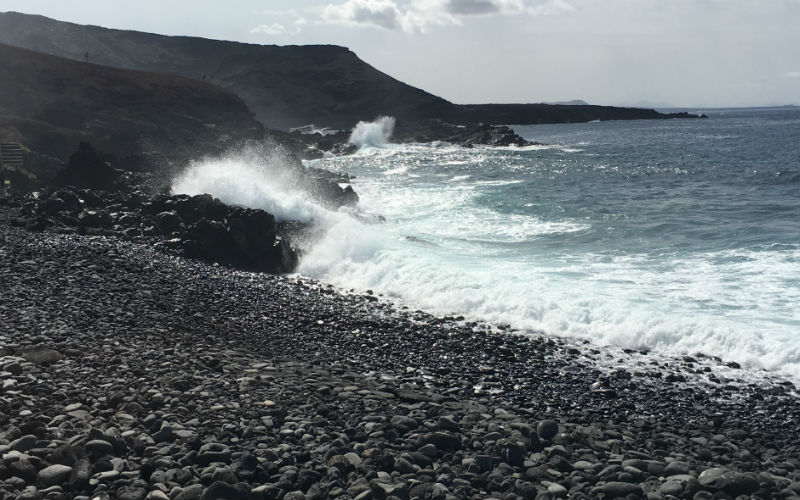
12. Los Hervideros and Playa Montaña Bermeja
Los Hervideros is a street of volcanic cliffs that make an incredible coast drive in the West of Lanzarote.
The black cliff faces create bizarre shapes and caves as hundreds of years of waves have eroded chunks of solidified lava.
The Northen part of the Los Hervideros ends with a lovely little beach, Playa Montaña Bermeja, complete with
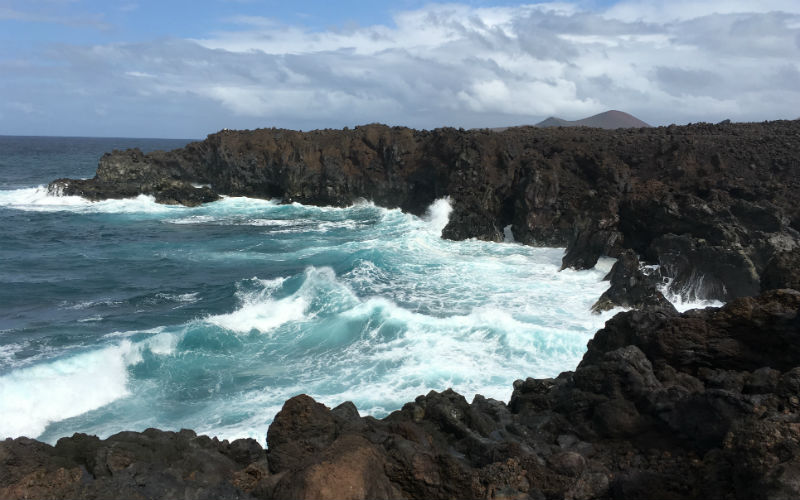
The beach starts off with rather large, chunky black stones that have been smoothed by the sea throughout the years. But as we got closer to the water, the stones get finer until we found the black sand.
It can be reached on a small loop road, the LZ-703, which is easily accessed from the LZ-2, the main road to the south.
There is also (as the name would suggest) a natural green lake to the side of the beach. The colour comes from a type of algae that makes its home there, and while I did see some people swimming in there, I wouldn’t want to myself.
The beach and lake also adjoin a large lava field so I was able to climb and explore the black stuff a little more. Be sure to take half decent shoes with you, as I found out the hard way that lava can be rather sharp and flip-flops don’t offer much protection!

Catch a glimpse of the breathtaking Lanzarote viewpoints
One of the biggest pleasures of driving is discovering scenic roads with wonderful viewpoints and Lanzarote does not disappoint.

13. Mirador Del Rio
This is the most famous of the viewpoints in Lanzarote, and rightfully so. Yet another brainchild of that man César, the Mirador Del Rio sits 400 metres up on the Risco de Famara cliff, overlooking the island of Graciosa and the Atlantic Ocean beyond.
We paid our entrance fee and walked into a large cafe with panoramic views of the island below. The white curves of the building gave it the feeling of a James Bond-esque lair from the 70s heyday of the movies.
I quickly moved to grab a table next to the window and we enjoyed a well made coffee (and chocolate donut) while taking in the view.

Once the coffee was finished and the donut demolished, we set out to explore a little further. There is a door to the outside where we could get right to the edge of the cliff and tested our nerves by looking over the edge.
There is also a second viewpoint, not to be missed, a little higher up. At the back of the cafe is a spiral staircase that leads to a stylish souvenir shop and a little higher up the second viewpoint.
While there is no doubt this is a stunning viewpoint, I did feel that having to pay to get in and then pay for the cafe as well, was a little uncalled for. While not super expensive, €4.50 per person, by the time you’ve added on a pit stop in the cafe, the cost does creep up.

Mirador Del Rio Visitor Information
Opening hours: 10am – 5:45pm
Cost of entrance: €4.50 per adult, children aged 7-12 €2.25
How much time to spend there: 30 mins not including cafe time
More info: Mirador del Rio
The rest of the viewpoints don’t have entrance fees or opening hours.
14. Las Salinas del Janubio
The Salinas is a curious viewpoint and beach which is also home to a salt-making business. The seawater is fed into various lagoons at different times and as the water evaporates, salt is left behind.
I’m sure there is probably much more to it than that, but the process seems simple in my mind.
What this creates is a patchwork of hues as the various lagoons are in different states of evaporation. A nice stop for a few minutes on your way to somewhere else, but unless you are using one of the restaurants in this area, I would not plan on spending more than a few minutes here.
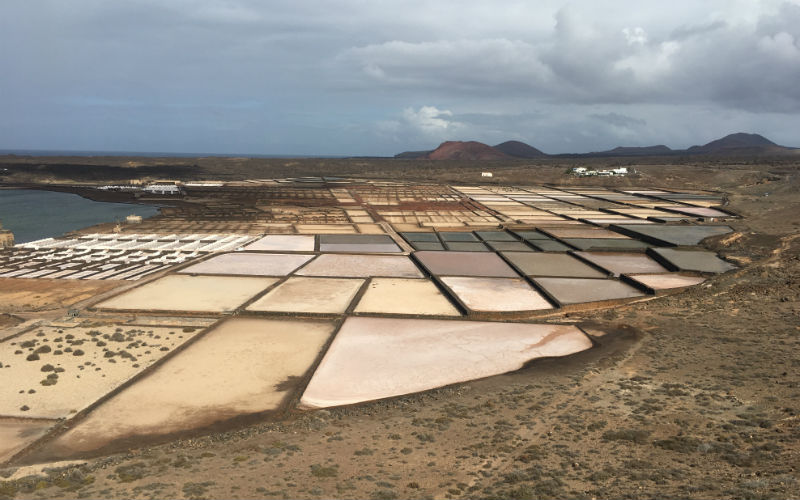
15. Other scenic viewpoints
As you drive around Lanzarote keep an eye out as there are viewpoints everywhere. A few more of my favourites are the Valle de Malpaso Haria, overlooking the village of Haria, the road up here is a perfect mountain road ascending quickly via a number of switchback bends.
Los Hervideros on the volcanic coastline and the Mirador de Ermita de las Nievas. Just be careful with the last one as the roads leading to it aren’t in the best condition.
Go underground in Lanzarote’s caves
The volcanic eruption of Mount Corona, 4000 years ago in the protected area of Monumento Natural del Malpaís de La Corona, left behind a web of
16. Jameos Del Agua
The Jameos del Agua is a Centre of Art, Culture and Tourism and another brainchild of Lanzarote artist César Manrique. His vision and creativity
While some feel that the caves are overworked and lost any natural beauty they once had, others agree that Jameos Del Agua has achieved its goal perfectly in creating an eco-tourist site that shows off the natural beauty of the lava tunnels while making it accessible and enjoyable for the many visitors.
Be sure to keep an eye out for the endemic Munidopsis
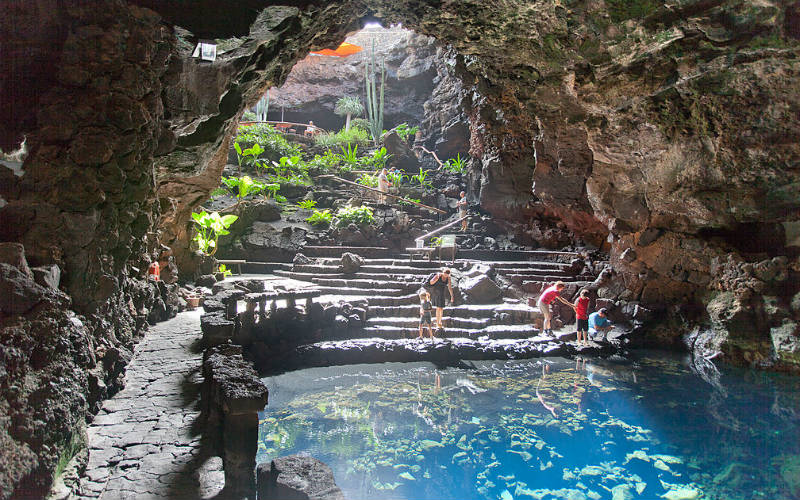
Photo credit: Lmbuga [CC BY-SA 3.0 ], from Wikimedia Commons
Visit Jameos Del Agua
Opening hours: 10am to 6:30pm
Cost of entrance: €9 adults, €4.50 for children aged 7-12
How much time to spend there: 2 hours
More info:
17. Cueva de los Verdes
Located just 200 metres away from the Jameos Del Agua, Cueva de los Verdes offers a slightly different experience in that it is much more natural. While there is still a lot of work that has been done there, a visit feels like more of an adventure than the Jameos Del Agua.
A visit to the caves takes place as a guided tour in which you slowly make your way through many of the lava tunnels. Some of them do get tight, so if you are super claustrophobic (and especially if you are with a large group) it may not be the best idea, but otherwise a wonderful exploration.
Remember to wear solid footwear as the ground can be a bit uneven underfoot.

Photo credit: Lviatour [CC BY-SA 3.0], from Wikimedia Commons
Cueva de los Verdes visitor Information
Opening hours: 10am to 6pm
Cost of entrance: €9 adults, €4.50 for children aged 7-12
How much time to spend there: The tour takes around 1 hour
More info: Cueva de
Get your shop on in a local Lanzarote market
Many of the small towns and villages of Lanzarote host markets throughout the week.
18. Teguise Market
Every Sunday from 9am to 2pm
Teguise Market is probably the most popular and well-known market in Lanzarote and is held every Sunday in Teguise where seemingly the whole of the island turns out. It’s a well-organized affair with car parking guides showing visitors to parking spaces and charging a couple of euros to park.
Although there were many people, the market didn’t feel busy as it is so large, taking over the entire town.
The market is home to stalls selling a wide range of goods including local crafts, fashion, art and much more. There is also a good selection of local shops with traditional clothing, local produce and wine (more on the Lanzarote wine coming up) and so on.

For me, however, the highlight of the day (as it often is) was lunch. There are many street food vendors available, but we found a small hotel and restaurant called Casa Palacio Ico.
Now while the food was not cheap, it was certainly tasty. We shared a whole baked seabass with the traditional local seasoning, mojo picon, and it was delicious. Juicy in all the right places.
However, delicious food aside, I have never encountered such a friendly team off staff, from the young man who welcomed us to the manager on the day.
Sorry, I’m going a little off track here, but I’m going to continue.
To give you a little context, my wife and I were actually on honeymoon in Lanzarote with our 14-month son. He had been playing up a bit, as toddlers do, and we hadn’t been able to properly relax and enjoy a meal together up until this point.
When our food arrived, the manageress, who had earlier told us that she has two kids of her own and sympathises with us, came and took our little Javi, held him, looked after him and basically baby sat him so we could enjoy our meal.
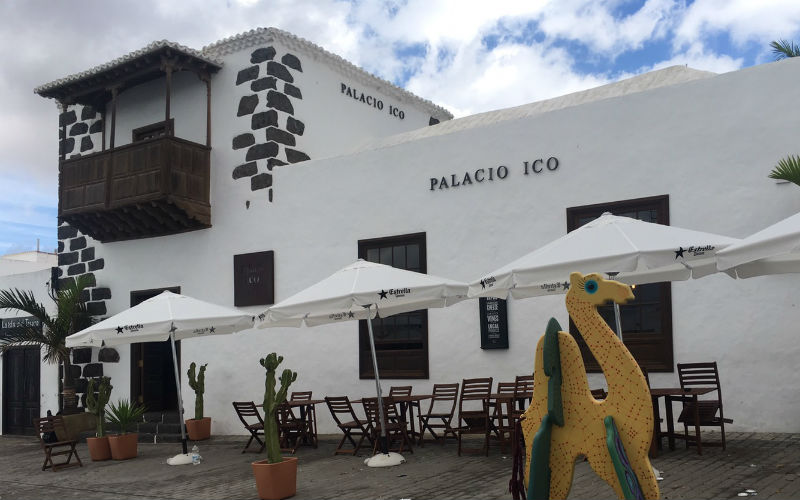
He had a busy time looking at all the fascinating things in the restaurant, being chased, and we could finally relax and enjoy a meal. He was never taken out of our sight, so it was 100% safe, and this small gesture almost (did) have me in tears.
If you have kids, you probably understand why that small act of kindness meant so much, we could relax and enjoy. If you don’t have kids yet but hope to, you’ll understand one day, and I hope you find somewhere like Casa Palacio Ico.
OK, back on track!
The rest of these markets we didn’t actually visit, however, I have included the information to help you plan your trip to Lanzarote.
19. Uga Market
Every Saturday and Sunday from 9:30am to 1:30pm
Uga is a town in the south of the island and also the gateway to the La Geria wine region. The market is twice a week and sells a wide range of local produce, wine and cheese as well as soaps and other health products made with local aloe.
20. Costa Teguise Night Market
Every Friday 5pm to 10pm
Each Friday evening, the Plaza Pueblo Marinero in Costa Teguise, comes to life with a handicraft night market. Not far from the beach marina, this is a perfect little spot so grab some Lanzarote souvenirs before heading for a beachside dinner in one of the many restaurants.
21. Playa Blanca Market
Wednesday & Saturday from 9am to 2pm
The Playa Blanca market takes place in the Marina Rubicón, to the east of the main clutch of Playa Blanca Hotels.
It would be necessary to catch a bus or grab a taxi if you are not in the immediate area, but it wouldn’t cost much to get there.
The market has a range of stall in a wonderful setting including artisanal products, handmade jewellery, crafts, fashion and much more.
There is also a smaller market in Playa Blanca every Friday morning in Punta Limones. This is where the smaller marina is located which is used by the passenger ferries between Lanzarote and Fuerteventura.
22. Puerto del Carmen
Every Friday from 10am to 2pm
Located in the Plaza de El Varadero de La Tiñosa, the small market sells a wide range of crafts and also offers entertainment throughout.
23. Arrecife Market
Every Wednesday and Thursday from 9am to 2pm
Arrecife is the capital of Lanzarote and markets are held each week in an area known as Charco de San Ginés, which is right down by the harbour. The market sells jewellery, crafts and fashion and there are also many fine restaurants to choose from in this area.
Enjoy Lanzarote wine
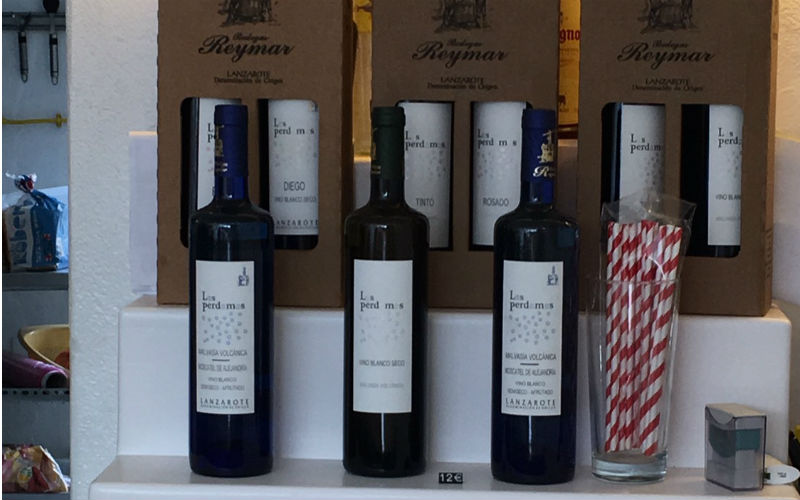
24. Visit the vineyards of La Geria
One of my favourite things to do in Lanzarote is sample the local wine. The region of La Geria is where almost all of the Lanzarote wine comes from and the good news is, most of the Lanzarote vineyards are open for wine tasting.
After the volcanic eruptions, the winemakers of Lanzarote had to go to extreme lengths to be able to produce wine once more. The result of their efforts was a unique type of viticulture in a fantastic climate making some wonderful wines.
Due to the nature of the vineyards, everything must be produced by hand which means Lanzarote wine isn’t cheap (compared to other Spanish wines) but is definitely good quality.
If you want to know more about the vineyards, check out my other post which has loads of information about the winemaking process and 10 Lanzarore Wineries that you can visit.

The small moon-shaped walls, known as zocos, protect the grapes during cultivation
Laze around on one of the best beaches in Lanzarote that are not volcanic
There is no doubt that the Canary Islands have some amazing beaches, but what about Lanzarote? Well, the island is famous for the black beaches mentioned earlier, there are also some wonderful regular beaches too. Here are a few of the other best beaches in Lanzarote:
25. Playa de Papagayo
This is in the
The beach is in a bay which means the emerald water is almost always calm. The water is also shallow, so an ideal beach for the kids.
The only drawback is that the beach is one of the more popular and can get busy, so try to get there early to snag your spot.
26. Playa de Famara
In the
The area is known for strong winds which can mean it’s not the perfect beach for a relaxing day at the
The small village of Caleta de Famara has a few schools and places where you can either take a lesson or simply hire the kite surfing equipment and try your luck!
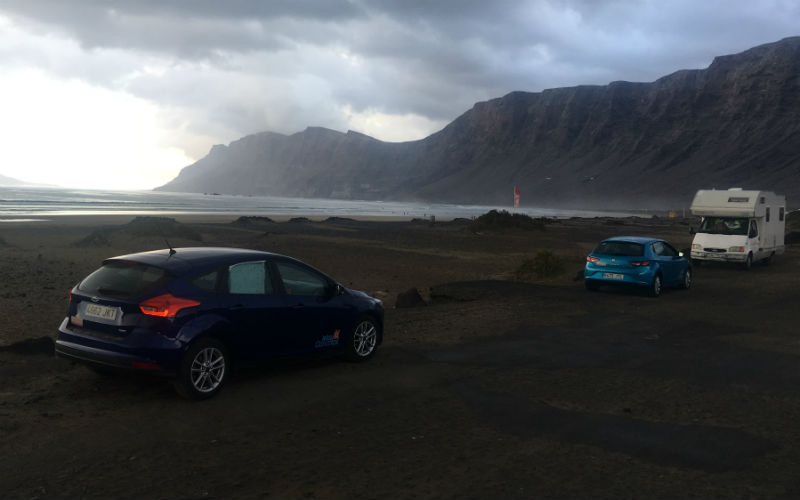
27. Playa de Orzola
We loved this beach that we discovered after visiting the Mirador del Rio in the north of Lanzarote. The beach was really quiet, which was wonderful, and we spent a couple of peaceful hours relaxing and soaking in the views.
The big drawback, however, is that due to the strong currents, there is no swimming, a little bit of paddling is fine, but don’t go too far.

La Graciosa
28. Visit the quiet little neighbour
La Graciosa is a small island just to the
The island is one to explore by foot or bicycle, which you can hire there, as cars are not allowed, and is home to some stunning beaches and coves with the most popular being Francesa Beach. However, the one that comes highly recommended is La Cocina.
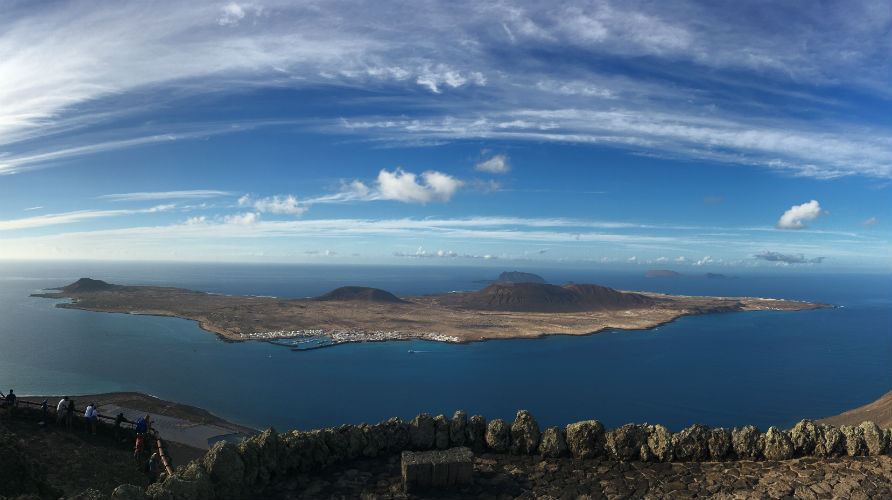
La Cocina beach is a little further away from the port than Francesa, so fewer people visit. The beach is at the foot of Montaña Amarilla, which translates to
The pure sand, crystal clear water, blue sky (hopefully) and yellow landscape all unite for a magical feeling. Throw in the isolation and you may not want to ever leave.
Getting to La Graciosa: Visitor Information
La Graciosa Ferry Hours:
Cost of entrance: Return trip €20 for adults, children €11
How much time to spend there: A whole day
More info: Gracioa ferry information
Things to do on Lanzarote final thoughts
So there you have it, a list of some of the many things you can do if you stretch your legs, go exploring and discover a little more of Lanzarote. I’m sure you will find something that will make you love the island even more.
I hope you have found something in my list that piqued your curiosity and will get you exploring during your visit to Lanzarote. I feel that a balance between poolside relaxation but still discovering the culture of the island that is welcoming you is key to getting the most out of your visit to Lanzarote.
What do you think? Are you visiting Lanzarote? If you have any questions feel free to leave them on the comment. Also, if you have been, is there anything I have missed?
Love it? Give it a pin 🙂
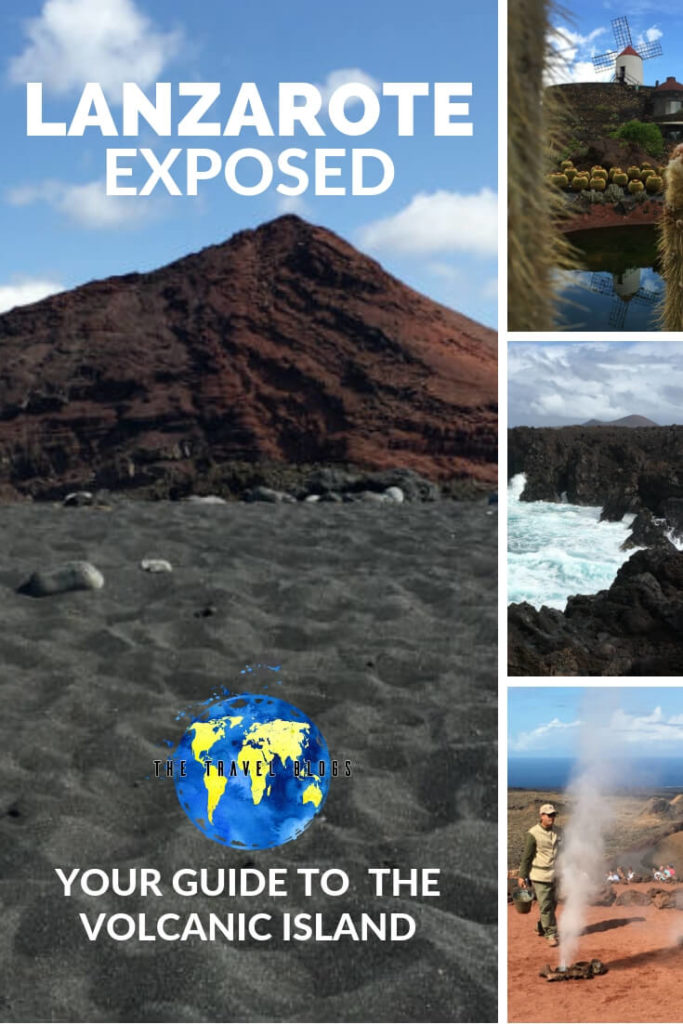
Are you a Travel Blogger?
If you want your blog to be added to our map be sure to check out our submit your blog page here: https://www.thetravelblogs.com/submit-your-blog

I have visited Lanzarote at the end of May 2019. I must say it is a incredible island. A lot of natural beauty. I would like to go back on day.
Very nice post! I really enjoy it reading, and also the pictures you take were fascinating! I really hope to go as soon as possible, I love Playa del Charco de Los Clicos & El Lago Verde it seems to be an extraordinary place to take some pictures!!
Wow! Really impressive places! I want to go and know them all!! My favorite was Jameos del Agua y Cueva de Los Verdes they seem really astonishing! The colors and the cristal water are just fantastic, I would definitely love to go especially to these places! Thanks for making this article so easy to read and for those great pics!